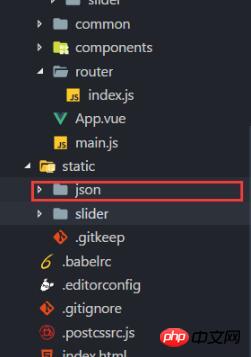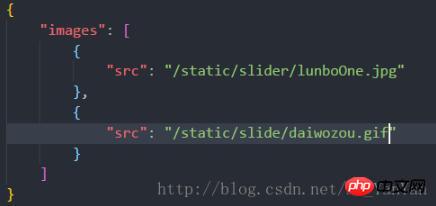About how vue implements dynamic loading of image src
Below I will share with you a solution to dynamically loading image src based on vue. It has a good reference value and I hope it will be helpful to everyone.
I haven’t blogged for a long time. I don’t know what I’ve been busy with recently. Anyway, I feel quite busy. In the group, I saw friends who are new to Vue asking about dynamic loading of images in Vue. They always get 404. situation, this article will briefly explain why it occurs and what are the solutions.
First of all, let’s explain the difference between the two files of vue-cli’s assets and static, because this will be helpful for you to understand the following solutions
assets: During the project compilation process, it will be processed and parsed into module dependencies by webpack. Only relative path forms are supported, such as < img src="./logo.png"> and background:url(./logo.png), "./logo.png" is a relative resource path, which will be parsed by webpack as a module dependency
#static: The files in this directory will not be processed by webpack, which simply means that third parties are stored The location of the file will not be parsed by webpack. It will be copied directly to the final packaging directory (default is dist/static). These files must be referenced using absolute paths, which are determined through the build.assetsPublic and build.assertsSubDirectory links in the config.js file. Any file placed in static/ needs to be referenced in the form of an absolute path: /static[filename]
According to the characteristics of webpack, in general, static files will not change. The third file, asserts Put files that may change
The problem comes, use js to dynamically load assets or pictures of this file and a 404 status code appears
Code example
<li v-for="(item,index) in images" :key="index">
<img :src="item.src"></li>
//js部分
data(){
return {
images:[{src:'./1.png'},{./2.png}]
}
}When I ran it, I found that the image was not displayed, and the error code was 404.
Reason: In webpack, images are used as modules. Because they are dynamically loaded, the url- The loader will not be able to parse the image address, and then the path will not be processed after npm run dev or npm run build [The path parsed by webpack will be parsed as /static/img/[filename].png, and the full address is localhost:8080/ static/img/[filename].png】
Solution:
①Load the image as a module , such as images:[{src:require('./1.png')},{src:require('./2.png')}] so that webpack can parse it.
②Put the images in the static directory, but the absolute path must be written such as images:[{src:”/static/1.png”},{src:”/static/2.png”}] In this way, the image will also be displayed. Of course, you can also shorten the writing length of the path by defining it in webpack.base.config.js.
Of course you said that when there are too many local pictures, it would be troublesome to write like this. Well, in fact, we simplify the operation like this.
Step one: Create a new json folder in static

Part 2: Fill in the json file, as shown in the figure

##Part 3: Introduce json into the response vue file , just parse the reference

Cross-domain issues with proxyTable in the vue-cli project
Use js custom trim function to delete spaces at both ends
The above is the detailed content of About how vue implements dynamic loading of image src. For more information, please follow other related articles on the PHP Chinese website!

Hot AI Tools

Undresser.AI Undress
AI-powered app for creating realistic nude photos

AI Clothes Remover
Online AI tool for removing clothes from photos.

Undress AI Tool
Undress images for free

Clothoff.io
AI clothes remover

Video Face Swap
Swap faces in any video effortlessly with our completely free AI face swap tool!

Hot Article

Hot Tools

Notepad++7.3.1
Easy-to-use and free code editor

SublimeText3 Chinese version
Chinese version, very easy to use

Zend Studio 13.0.1
Powerful PHP integrated development environment

Dreamweaver CS6
Visual web development tools

SublimeText3 Mac version
God-level code editing software (SublimeText3)

Hot Topics
 How to use bootstrap in vue
Apr 07, 2025 pm 11:33 PM
How to use bootstrap in vue
Apr 07, 2025 pm 11:33 PM
Using Bootstrap in Vue.js is divided into five steps: Install Bootstrap. Import Bootstrap in main.js. Use the Bootstrap component directly in the template. Optional: Custom style. Optional: Use plug-ins.
 How to add functions to buttons for vue
Apr 08, 2025 am 08:51 AM
How to add functions to buttons for vue
Apr 08, 2025 am 08:51 AM
You can add a function to the Vue button by binding the button in the HTML template to a method. Define the method and write function logic in the Vue instance.
 How to use watch in vue
Apr 07, 2025 pm 11:36 PM
How to use watch in vue
Apr 07, 2025 pm 11:36 PM
The watch option in Vue.js allows developers to listen for changes in specific data. When the data changes, watch triggers a callback function to perform update views or other tasks. Its configuration options include immediate, which specifies whether to execute a callback immediately, and deep, which specifies whether to recursively listen to changes to objects or arrays.
 What does vue multi-page development mean?
Apr 07, 2025 pm 11:57 PM
What does vue multi-page development mean?
Apr 07, 2025 pm 11:57 PM
Vue multi-page development is a way to build applications using the Vue.js framework, where the application is divided into separate pages: Code Maintenance: Splitting the application into multiple pages can make the code easier to manage and maintain. Modularity: Each page can be used as a separate module for easy reuse and replacement. Simple routing: Navigation between pages can be managed through simple routing configuration. SEO Optimization: Each page has its own URL, which helps SEO.
 How to return to previous page by vue
Apr 07, 2025 pm 11:30 PM
How to return to previous page by vue
Apr 07, 2025 pm 11:30 PM
Vue.js has four methods to return to the previous page: $router.go(-1)$router.back() uses <router-link to="/" component window.history.back(), and the method selection depends on the scene.
 How to reference js file with vue.js
Apr 07, 2025 pm 11:27 PM
How to reference js file with vue.js
Apr 07, 2025 pm 11:27 PM
There are three ways to refer to JS files in Vue.js: directly specify the path using the <script> tag;; dynamic import using the mounted() lifecycle hook; and importing through the Vuex state management library.
 How to use vue traversal
Apr 07, 2025 pm 11:48 PM
How to use vue traversal
Apr 07, 2025 pm 11:48 PM
There are three common methods for Vue.js to traverse arrays and objects: the v-for directive is used to traverse each element and render templates; the v-bind directive can be used with v-for to dynamically set attribute values for each element; and the .map method can convert array elements into new arrays.
 How to jump to the div of vue
Apr 08, 2025 am 09:18 AM
How to jump to the div of vue
Apr 08, 2025 am 09:18 AM
There are two ways to jump div elements in Vue: use Vue Router and add router-link component. Add the @click event listener and call this.$router.push() method to jump.






